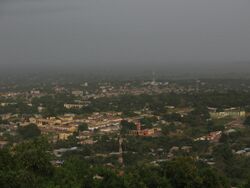Physics:Harmattan
| Part of the nature series |
| Weather |
|---|
The Harmattan is a season in West Africa that occurs between the end of November and the middle of March. It is characterized by the dry and dusty northeasterly trade wind, of the same name, which blows from the Sahara over West Africa into the Gulf of Guinea.[1] The name is related to the word haramata in the Twi language.[2] The temperature is cold mostly at night in some places, but can be very hot in certain places during daytime, all can also depend on local circumstances.[3]
The Harmattan blows during the dry season, which occurs during the months with the lowest sun. In this season the subtropical ridge of high pressure stays over the central Sahara and the low-pressure Intertropical Convergence Zone (ITCZ) stays over the Gulf of Guinea. On its passage over the Sahara, the Harmattan picks fine dust and sand particles (between 0.5 and 10 microns). It is also known as the "doctor wind", because of its invigorating dryness compared with humid tropical air.
Effects
This season differs from winter, because it is characterized by cold, dry,[4] dust-laden wind, and also wide fluctuations in the ambient temperatures of the day and night. Temperatures can easily be as low as 9 °C (48 °F) all day, but sometimes in the afternoon the temperature can also soar to as high as 30 °C (86 °F), while the relative humidity drops under 5%. It can also be hot in some regions, like in the Sahara.[5]

The air is particularly dry and desiccating when the Harmattan blows over the region.[4] The Harmattan brings desert-like weather conditions: it lowers the humidity, dissipates cloud cover, prevents rainfall formation and sometimes creates big clouds of dust which can result in dust storms or sandstorms.[citation needed] The wind can increase fire risk[6] and cause severe crop damage.[7] The interaction of the Harmattan with monsoon winds can cause tornadoes.[1]
Harmattan haze
In some countries in West Africa, the heavy amount of dust in the air can severely limit visibility and block the sun for several days,[8] comparable to a heavy fog. This effect is known as the Harmattan haze. It costs airlines millions of dollars in cancelled and diverted flights each year.[9][10] When the haze is weak, the skies are clear.[11] The extreme dryness of the air may cause branches of trees to die.[12]
Health
A 2024 study found that dust carried by the Harmattan increases infant and child mortality, as well as has persistent adverse health impacts on surviving children.[13]
Humidity can drop lower than 15%, which can result in spontaneous nosebleeds for some people.[7] Other health effects on humans may include conditions of the skin (dryness of the skin), dried or chapped lips, eyes, and respiratory system, including aggravation of asthma.[14]
See also
- Khamsin
References
- ↑ 1.0 1.1 "Harmattan". Encyclopædia Britannica. http://www.britannica.com/science/harmattan. Retrieved 22 July 2015.
- ↑ "Harmattan". Harmattan. 2012. http://www.merriam-webster.com/dictionary/Harmattan.
- ↑ Geographical Review (1919): "Knox writes of this wind : The Harmattan is experienced as a wind which blows, especially in the months of December, January, and February, from the NE. and is a hot wind in some localities and a cold wind in others, according to circumstances."
- ↑ 4.0 4.1 Minka, Ndazo Salka; Ayo, Joseph (2014). "Influence of cold–dry (harmattan) season on colonic temperature and the development of pulmonary hypertension in broiler chickens, and the modulating effect of ascorbic acid". Open Access Animal Physiology: 1. doi:10.2147/OAAP.S51741.
- ↑ Climate and Land Degradation. Environmental Science and Engineering. 2007. doi:10.1007/978-3-540-72438-4. ISBN 978-3540724377. "At the southern fringe of the Sahara Desert, a special dry and hot wind, locally termed Harmattan, occurs."
- ↑ Oladipupo, Akolade R (13 December 2014). "Harmattan: Behold A Season". Leadership. http://leadership.ng/entertainment/394904/harmattan-behold-season.
- ↑ 7.0 7.1 Terazono, Emiko; Blas, Javier (19 January 2012). "Saharan wind stirs cocoa market". Financial Times. http://www.ft.com/cms/s/0/b681e5f0-42b7-11e1-b756-00144feab49a.html#axzz1kkb8Prrr.
- ↑ "Tuareg unrest". Temoust. 7 September 2007. http://www.temoust.org/spip.php?article3206.
- ↑ Eze, Chinedu (15 January 2013). "Nigerian Civil Aviation warns pilots, airlines of Harmattan haze". This Day. http://allafrica.com/stories/201301150511.html.
- ↑ Valdmanis, Richard (8 February 2012). "Giant dust cloud chokes west Africa". Reuters. https://af.reuters.com/article/topNews/idAFJOE81706Z20120208.
- ↑ Akinrefon, Dapo (16 December 2014). "As harmattan finally hits Lagos". http://www.vanguardngr.com/2014/12/harmattan-finally-hits-lagos/.
- ↑ "Arago on Comets". The North American Review (Boston: Charles Bowen) 42 (90): 213. January 1836. https://books.google.com/books?id=aqNKAAAAcAAJ&pg=PA213.
- ↑ Adhvaryu, Achyuta; Bharadwaj, Prashant; Fenske, James; Nyshadham, Anant; Stanley, Richard (2024). Dust and Death: Evidence from the West African Harmattan (Report). The Economic Journal. https://doi.org/10.1093/ej/uead088.
- ↑ Anuforo, Emeka; Chukwu, Lilian (20 January 2015). "Coping With Health Hazards of Harmattan Haze". Rivers State News. http://www.riversstatenews.com/coping-with-health-hazards-of-harmattan-haze/.
External links
 |


